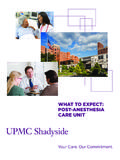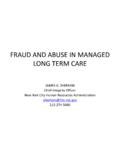Transcription of y term BaB Pre Care For t - World Health …
1 Photo: NameCare For the Preterm BaByPhoto: Ritam Banergee/ Getty Images for Save the Children61 Joy E Lawn, Ruth Davidge, Vinod Paul, Severin von Xylander, Joseph de Graft Johnson, Anthony Costello, Mary Kinney, Joel Segre, Liz Molyneux5 care for thE PrEtErm BaBy61 Chapter for the preterm babyPreterm baby survival and care round the worldEach year 15 million babies are born preterm and their survival chances vary dramatically around the World (Blencowe et al., 2012) (Figure ). For the million babies born in high income countries, increasing complex-ity of neonatal intensive care the last quarter of the 20th century has changed the chances of survival at lower gestational ages.
2 Middle-income and emerging econo-mies have around million preterm babies each year, and whilst some countries such as Turkey have halved deaths for preterm babies within a decade, other countries have made minimal progress (Chapter 6). South Asia and sub-Saharan Africa account for almost two-thirds of the World s preterm babies and over three-quarters of the World s newborn deaths due to preterm birth complications (Chapter 2). Worldwide, almost half of preterm babies are born at home, and even for those born in facilities, essential newborn care is often premature babies (>80%) are born between 32 and 37 weeks of gestation (moderate/late preterm), and die needlessly for lack of simple, essential care such as warmth and feeding support.
3 About 10% of preterm babies are born 28 to <32 weeks gestation, and in low-income countries more than half of those will die but many could be saved with feasible care , not including intensive care such as ventilation (Figure ). For babies born before 28 weeks gestation, intensive care would be needed to save most of these, but it is important to Low-income countriesHome birth and care at home ( million preterm babies)High-income countriesAccess to full intensive care ( million preterm babies)Middle-income countriesNeonatal care units( million preterm babies)Low-income countriesFacility births but limited space, staff and equipment( million preterm babies)Figure : Worlds apart: the four settings where 15 million preterm babies receive carePhoto: Pep Bonet/NOOR/Save the ChildrenPhoto: Save the ChildrenPhoto: Bill & Melinda Gates Foundation/Frederic CourbelPhoto.
4 GAPPS/Seattle s ChildrenThe Global Action Report on Preterm Birth62realize that these are the minority about 5% of prema-ture babies. Yet in many countries, families and Health care providers still perceive the deaths of any premature baby as contrast, neonatal survival is extending to lower and lower extremes of gestational age in high-income set-tings. In 1990, few babies under 25 weeks gestation were surviving; yet by 2010, 95% of preterm babies under 28 weeks survived, and more than half of the babies born before 25 weeks gestation survived, although the latter have a higher risk of impairment (Petrou et al., 2006). Over the last few decades the survival gap for babies born in high-income countries and babies born in the poorest countries has widened dramatically, even though the pace of survival gains in high-income countries has slowed reaching the extremes of preterm gestation.
5 For example, North America is still achieving an average annual reduction of more than 5% per year for preterm-specific mortality, yet Africa on average is improving mortality rates for preterm babies by only 1% a year (Figure ). Those countries with the highest risk of death and the most fea-sible deaths to avert are still experiencing the least prog-ress. The history of neonatal care in high income countries shows that the major reduction in deaths occurred before neonatal intensive care was established. Yet the risk of a neonatal death due to complications of preterm birth is about twelve times higher for an African baby than for a European baby (Liu et al., 2012) (Figure ).An important but under-recognized issue for all countries is that of disability for survivors of preterm birth (see Chapter 2).
6 In the early days of neonatal intensive care , disabilities were common amongst survivors, ranging from some school learn-ing disability through to severe cerebral palsy. Impairment outcomes have a heavy toll on families and on the Health system. Indeed a recent report estimated that the average baby born 28 to 31 weeks gestation in the United States costs $95,000 in medical care in the first year alone (Behrman and Butler, 2006). Over time the pattern of impair-ment from preterm birth in high-income countries has shifted. The focus of intensive care has shifted to extremely premature babies (less than 28 weeks), or micro pree-mies as this smaller sub-set of babies has increased risk and severity of impair-ment (Marlow et al.)
7 , 2005; Petrou et al., 2006). I never thought that this baby would survive; I thought it would die any time Mother of moderately preterm baby at home in Eastern Uganda (Waiswa et al., 2010)Figure : 135 million newborns and 15 million premature babies - Health system needs and human capital outcomes Source: Analysis using data from Blencowe et al., 2012; Cousens et al., 2011; Liu et al., 2012780,000babies< 28 million babies28- weeks gestational million babies32 to weeksgestational ageTERM BABIES120 million, including about 5 million term low-birthweight babiesHEALTH SYSTEM care NEEDEDLOSS OF HUMAN CAPITALE ssential maternal and newborn careExtra care for small babiesCare of preterm baby with complicationsIntensive neonatal careFamilysupport after deathIncreased Health and care load in later lifeCare for childrenwith disability.
8 Family million million neonataldeathsChildren with moderate or severe long term disabilityChildren with mild long term disability eg learning or behaviorOther long term effects higher risk of non communicable diseases5 care For The PreTerm BaBy63 Recent data show that even late and moderate preterm (LAMP, or 32 to <37 weeks gestation) is also associated with significant adverse effects, including on school learning, prompting increasing debate regarding avoidable causes of moderate preterm birth such as high cesarean birth rates (Osrin, 2010; Shapiro-Mendoza and Lackritz, 2012). These long-term effects on society and on the Health system as well as more evidence of the link with non-communicable diseases in later adult life (see Chapter 1) underline that importance of addressing preterm birth is beyond the last four decades with an increasing evidence-based care for premature babies in high-income coun-tries, the risk of long-term impairments is reducing.
9 Neonatal intensive care has also become less inter-ventionist and hence some aspects are also potentially more feasible to adapt to lower-income settings. Notable advances in quality of intensive care for premature babies include: Widespread use of antenatal corticosteroids in high- and some middle-income countries following multiple RCTs and the National Institute of Health consensus statement ( The effect of antenatal steroids for fetal maturation on perinatal outcomes statement, 1994), ensuring that babies are less likely to develop respi-ratory distress syndrome (RDS), or have less severe RDS (Mwansa-Kambafwile et al., 2010; Roberts and Dalziel, 2006). A shift to less intensive ventilator pressures and increasing use of continuous positive airway pressure (CPAP), now often the respiratory support method of choice (De Paoli et al.)
10 , 2003). Detailed quality of care protocols and job aids for almost every aspect of care have improved quality and also shifted more care to the responsibility of skilled neonatal nurses, particularly with respect to addressing infection prevention, feeding support, use of intravenous fluids, and safe oxygen use with careful tracking of oxygen saturation levels (Sola et al., 2008) and follow-up services. Deliberate attention to baby friendly care , reducing pain and over stimulation and more family friendly care , including family rooms linked to neonatal units and increased access for parents to their babies while in neonatal care units. (Symington and Pinelli, 2003).In low- and middle-income countries, there are limited comparable data on long-term outcomes after preterm Developed regionLatin Amercia & the CaribbeanCentral and East AsiaNorth Africa and West AsiaSouth-east Asia & OceaniaSouthAsiaSub-Saharan AfricaMortality per 1,000 live births0102030405152535453221107741178411 8961399726142112271423122000 20102000 20102000 20102000 20102000 20102000 20102000 2010 Preterm birthOther neonatal causesFigure : Increasing survival gap for preterm babies around the World : Regional variation in preterm birth as direct cause of neonatal deaths showing change between 2000 to 2010 Source.


















